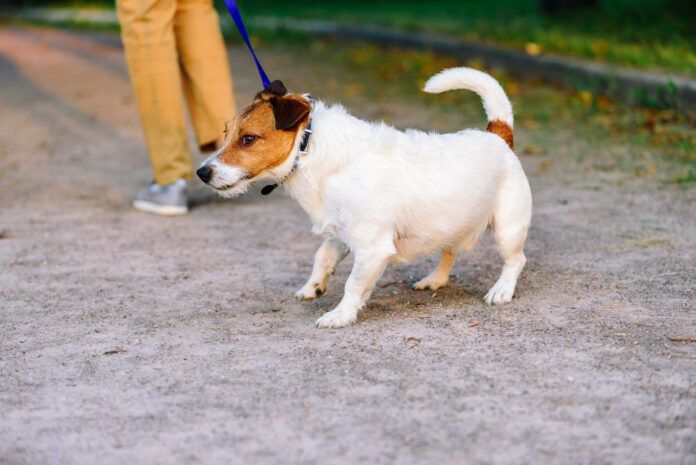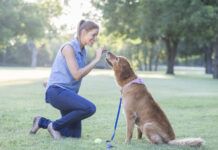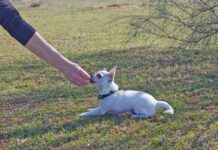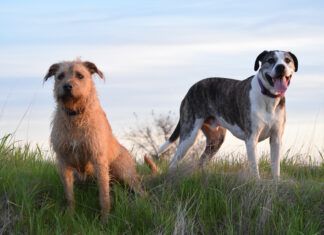
One of the most common requests humans bring to dog trainers is this: “Can you just stop my dog from pulling on the leash so much?”
The funny thing is, if dogs could hire human trainers, here’s what they’d say: “Can you just stop him from pulling on the leash so much?” They might even add, “Come to think of it, can you just stop him from constantly manhandling my body, when a simple, polite request would do?”
There are many times when it seems more expedient to use your superior strength (or training tools that increase your ability to physically control your dog) instead of using your intelligence to get your dog to do what you’d like. How often do you tug, pull, push, or lift your dog (perhaps using his leash as a steering wheel or his collar or harness as a handle) to get your dog to do something that they were slow to do by themselves?
Don’t feel too bad; even people who consider themselves to be entirely committed to force-free training techniques resort to picking up a dawdling small dog sometimes. Impatience is a very human condition!
But if your dog frequently uses his body to get what he wants – by knocking into you, pawing at you, jumping on you, or pulling on leash – I beg you to take just one day to notice that this dynamic works both ways. Folks, your dogs are learning this world’s rules from you.
There’s a better way. Instead of relying on physical force, employ that big brain of yours. How many times today can you resist the quick and easy way of getting your dog where you want him and instead begin creating a collaborative dynamic that serves you both beautifully? Challenge yourself to use your voice, your body language, your treats, and your bond with your dog to communicate your desires regarding his behavior – and to let him know how much you appreciate his cooperation.
GIVE A HEADS-UP: HOW TO COMMUNICATE WITH YOUR DOG
Pro tip: Start by using your words!
Let’s say, on your dog walk, you’ve stopped to chat with a friend or to wait for the signal to cross the street. Your dog is waiting patiently, sitting politely or standing quietly, perhaps watching some kids down the street – when suddenly you’re done with the conversation or the crossing indicator turns green, and you yank him out of his reverie to begin walking again. Rude!
Here’s what that tug-out-of-nowhere teaches your dog: First, it drives home the point that weird and sudden leash pressure is a way of life – so now it won’t feel strange to him when he creates that pressure himself by pulling or dashing. Second, it teaches him to be on guard for one of those yanks, to never fully relax on a walk with you. That makes your walks open season for pull-and-yank, plus a bit of anxiety. I’ll argue that’s not a small thing.
It’s so easy to do better. Simply give your dog a heads-up – an invitation. That’s all! Before taking a step, just cue your dog. It’s as easy as saying, “Okay, Spot, let’s go!” You could also pat your thigh or make a clicking or kissing noise – any kind of communication that loops your pup into the plan.
This change may seem miniscule, but when you watch it in action, you suddenly see a team. It’s huge.
(I’m focusing here on just a single moment of the walk, but for a whole article on teaching loose-leash walking, see “Polite Leash Walking,” September 2021.)
USE YOUR BRAIN TO MOVE YOUR DOG

Just today one of my favorite clients mentioned that her dog gets testy whenever her collar is grabbed. My question: Why are you grabbing her collar so much?
As simple as it feels to us to snag our dogs by that omnipresent handle, in the long run, it’s interfering with the behavior and the relationship we want. Try using your brain to move your dog, not your muscles:
- Want your dog to get off the couch? Don’t grab his collar, just stick out your hand and say “touch.” (If you haven’t taught this most useful of all cues, do it today! See “On Target Training,” September 2021.)
- Want your dog to hold still so you can put on the leash? Don’t grab his collar, just ask for a sit.
- Want to interrupt your dog’s chase of the cat? Don’t grab his collar, just scoot in the opposite direction with a toy and call him in a crazy-happy tone of voice. Reward him when he comes to you!
The collar grab, like the leash yank, is an instinctive, lowest-common-denominator way we humans get control. It’s easy to be in the habit of using this kind of low-level physical force all day long. If you don’t think about it very much, it seems normal.
But I implore you to think about it. The more you do, the stranger it seems to so casually and frequently use our superior physical strength to force our best friends – these sentient, intelligent souls who are fully capable of learning the most intricate behaviors – to put their bodies exactly where we want them.
Some dogs accept this constant contact with resignation, but many others mentally tune out when they can’t seem to escape these unpleasant physical intrusions, and even come to rely on the barrage of yanks, pushes, and pulls for direction. A few, like my client’s dog, start to growl or show other signs of defensive aggression in an effort to stop the assaults.
Remember, in every interaction we have with our dogs, we are teaching them who we are. Ponder what vibe you want to teach. Personally, I want to have a friendly, fun, trusting, and respectful relationship with my dogs – and I see plenty of evidence that makes me believe that they want that, too.
CHALLENGE YOURSELF WHEN COMMUNICATING WITH YOUR DOG!
Years ago, in one of the most fun dog-training classes I’ve been to, the instructor had us all tie a loose knot – maybe four inches in diameter – in the middle of our leashes. Then we spent 10 minutes walking around the facility in a line, passing each other over and over. The winner was the one who had the loosest knot after all of that.
To accomplish this, we used happy voices, kissy noises, and dancing steps. We made the most of cues like “touch” and “look” and “heel” and “side” and “walk with me.” There was cheese and chicken, along with a robust history of positive reinforcement in this scenario. It was a blast. Why? Because it showed us how very far we had come from the days when we, too, thought it was normal to just pull your dog around. It was a reflection of how much more rewarding and cooperative our relationships with our dogs had become.
So, give it a try. Watch what happens when you start communicating with your dog, rather than using your superior physicality to go places and/or do things with him. I think you’ll find that your time with your dog quickly becomes less of a struggle and more enjoyable, as it should be when you experience life in sync with a respected friend.
How loose is your knot?






Loved — and learned a lot from — this article. And when I reached the end and saw your byline, I somehow wasn’t surprised!
Aw, hi Jill!!! 🙂 Thank you. (I’m just back from a weekend in Hanover where of course it snowed as I dropped a kid off for spring term… )
Would this work when a dog wants to say hello to another dog? Otherwise he walks lovely and is responsive.
Your article made an important connection for me. I’ve just been reunited with my birthfather, a giant of a man. He uses his size to intimidate and impose his will on everyone around him. Unpleasant at best. I now understand how our rescue furbaby feels when we demand instead of asking. Thank you for helping me become a better mama!
My dog (97 lb Setter) behaves on a leash until he sees or scents one of the feral cats that live near me – then he wants to hunt or chase and will try to drag me after the cat. Show him a toy ??? You must be joking – his prey drive is WAY stronger than his play (or food) drive. If I cover his eyes with a snood, things are a bit easier – he can smell a cat but can’t see one. Once we are past the cat area, he is very reasonable. There is no way to get from the house to the car without passing the cat area.
There is a way to relax dogs while grabbing their collar. First grabbing may not be the right word because it gives a sense of urgency and physical force: I need taking the collar to lead the dog from point a to point b when leashes are not immediately available or when there is a new situation asking for it. In this case, using counter-conditionning is a good way to make them like being touched by the neck.
Interesting article, except that I am a petite 78-year-old woman, and my dogs are 2, 2 year old, 1/2 Great Pyrenese, 1/2 Saint Bernard huge dogs. I haven’t tried to walk them yet. My son walks them 2 or 3 times a day and tells me his stories of woe. I’ve trained Great Pyrenese dogs to walk with me like angels. They have usually been more concerned with my well-being than their own. One, I had to train by keeping him at my hip til he understood that “heel” meant he should stay at my hip. Nothing else had worked. My biggest problem is that these two want to jump on me to show their love. If I fall, as a result, I am in danger of being injured. Of course, I try to fall on top of them if I’m falling. And I would use the dog to get myself back up. I’ve already done that. But the biggest problem is that they continue to jump up on me despite loud repeated “NO”. So far I only walk around with them in the fenced yard and hold something for defense. I’ve been working on “sit” and “down.”
I get you Frances! I have 3 dogs, a mini poodle, a rescue (a little smaller than the mini, both 8 years old), and a standard poodle,
who is afraid of everything (age 2). I take them on a walk and talk, let them read their pee-mail, eat grass, smell the flowers, and take care of other business. But, sometimes when direction is needed quickly and quietly, words are not near enough.
Francis Friedman. Your 2 large dogs sound lovely, but I can’t help but wonder whether “you’ve bitten off rather more than you can chew” in getting them at age 78? I’m a woman of a similar age, and while I’m very healthy, and I love to walk my dog around 25 to 35 city blocks every day the weather permits, I do know that I’d find having 2 large, young, dogs to be way too much to handle! I have a wonderful rescue dog, he’s very active, but he’s a small dog weighing only 8.lbs. Manageable without having to rely on anyone else to help me with him, plus at his size he’s unlikely to cause me to fall.
Hi, great article, thank you. I’d love to know where the photo for the loose knot example came from please as that dog is the spitting image our our Romanian rescue!
Not every dog force to move aside or somewhere else. You have to make a routine of your dog on daily basis when he/she is a pup to go outside with you and enjoy the environment according to your perspective and your need.
Dog collars are antiquated and can harm your dog when tugged or pulled.
Go the modern and humane way by using a saddle and trash that torturous
Collar.
Your dog will be more comfortable and enjoy the walks more !!!
I couldn’t agree more. I’m in the voice acting business so I’m trained to use my voice to lead all kinds of animals including people to a specific goal or product. I’ve got a poochon, a Bichon Frise and poodle mix…That’s totally Bichon personality so at first after her Rescue by me it was a challenge to remain calm and not tug, especially when she was ready to dash into the street before a light had changed to walk, but with patience she came along and understood it. In fact now she actually looks both ways after looking at me to make sure traffic is cleared and that I’m ready to walk with her. And she pays strict attention to voice commands/requests!
My lovely dog is very well behaved in the house or the back yard. But absolutely goes deaf when leashed and I open the back gate. Heel, sit, stay seem to mean absolutely nothing to him for the first quarter mile. Treats mean nothing to him for the first quarter mile. I feel that if I took him for a walk every day, he might calm down but that first quarter mile is hard on me. I am 85 and he is 4.
Thank you for this. Lately I’ve tried to imagine what it’s like to be harnessed and on a leash at the whim of someone. Sometimes I’d be lunging to run after a squirrel and “wham” I’m abruptly stopped by the leash. Or I’m going along happily loose leash, and then it seems suddenly I’m yanked away from something. It seems horrible and I’d love to minimize my use of the leash. I’m perfectly happy for my girl to stop and read peemail, sniff here and there to her heart’s content, dawdle — I feel our walks are all about her. BUT the problem is she is extremely driven to find things to eat and when she seems like she may be onto something, I feel I have to stop her because so often she has grabbed a chicken bone or eats something that makes her sick. It’s a real dilemma. Also, probably due to the leash, she often barks and lunges at dogs she doesn’t know and I feel a need to restrain her. Well there’s a back story and this is already too many words. I’ve made a bit of headway with treats and frequent eye contact, but it’s slow going.
Great article! I looked out my window this morning, in time to see someone carrying a mid-size poodle pup who didn’t feel like walking anymore — so, what you said!
My issue was with two of my dogs (I am currently without dog and not liking it.) Wonderful on leash. But when I would stop to talk with a neighbour or anybody, they would start looking up at me and barking. I think this is the “Hey, I’m down here, remember?” and wanting attention. What do I do to stop the barking without giving attention? I don’t like to give them attention by talking to them to stop or lie down or give them a treat. Its a conundrum.